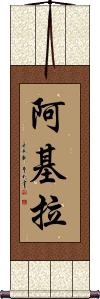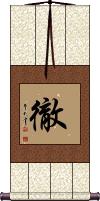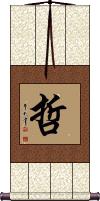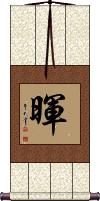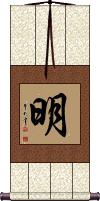Many custom options...
And formats...

Akira in Chinese / Japanese...
Buy an Akira calligraphy wall scroll here!
Personalize your custom “Akira” project by clicking the button next to your favorite “Akira” title below...
Akira
Akira
Tetsu / Penetrating
徹 is commonly used in Japan as a given name, romanized as Tetsu.
The meaning of this Kanji is: thorough; penetrating; to pervade; to pass through; pervious; perspicacious; throughout; communal.
徹 can also be romanized as Michi; Tooru; Touru; Tetsuji; Tsuyoshi; Choru; Osamu; Itaru; or Akira.
Tetsu / Wise Sage
哲 is a Japanese name that is often romanized as Tetsu.
The meaning of the character can be: philosophy; wise; sage; wise man; philosopher; disciple; sagacity; wisdom; intelligence.
哲 can also be romanized as: Yutaka; Masaru; Hiroshi; Tooru; Tetsuji; Choru; Satoru; Satoshi; Akira; Aki.
Hikari
暉 is a Kanji that often represents a Japanese name romanized as Hikari.
The literal meaning can be sunshine, light, or to shine upon. It has the same meaning in Chinese and Korean. From ancient Chinese, it is a variant of 輝/辉.
Other Japanese romanizations include Hikaru, Hikatsu, Teru, Terasu, Ki, and Akira.
Yoko / Brilliant / Glorious
燿 means brilliant or glorious in Chinese, Japanese Kanji, and old Korean Hanja.
I am listing this character as it is a common Japanese given name that is romanized as Yoko or Youkou. It can be romanized as these names as well: Yo, Teru, and Akira.
As with most Japanese names, this is not the only character or only name that romanizes as Yoko. Be sure you are getting the correct character before you order.
露 is the Chinese, Japanese Kanji, and old Korean Hanja for dew.
Depending on the context in which this character is used, it can also mean: tears; syrup; nectar; outdoors (not under cover); to show; to reveal; to betray; to expose; scanty; bare; unconcealed; naked; public.
露 can be a Chinese surname Lu. 露 can also be the Japanese surname Tsuyuzaki or Tsuyusaki, and the given names Tsuyu or Akira.
Oddly, 露 is sometimes used as an abbreviation for Russia.
In the Buddhist context, 露 also means dew, but can be a symbol of transience. Sometimes used as a metaphor to expose or disclose knowledge and truth.
Light / Bright
明 means light, bright, clear, clarity, to understand, or wise.
In Chinese, this can refer to the Ming Dynasty (1368-1644) where it can also be the surname Ming.
In Japanese, this can be romanized many different ways when used as surnames or given names. 明 is a partial list of those names: Meishuu, Mei, Min, Myoujin, Myou, Hinata, Haru, Toshi, Tooru, Sayaka, Saya, Satoshi, Asumi, Akera, Akemine, Akesaki, Ake, Akuru, Akiraka, and Akira.
In the Buddhist context, this represents vidyā (knowledge). To expand that, Buddhists understand this to mean bright, clear, enlightenment, wisdom, or to understand. It represents Buddha-wisdom and its revelation; also the manifestation of a Buddha's light or effulgence.
The following table may be helpful for those studying Chinese or Japanese...
| Title | Characters | Romaji (Romanized Japanese) | Various forms of Romanized Chinese | |
| Akira | アキラ | akira | ||
| Akira | 阿基拉 | ā jī lā / a1 ji1 la1 / a ji la / ajila | a chi la / achila | |
| Tetsu Penetrating | 徹 彻 | tetsu | chè / che4 / che | ch`e / che |
| Tetsu Wise Sage | 哲 | tetsu | zhé / zhe2 / zhe | che |
| Hikari | 暉 晖 | hikari | huī / hui1 / hui | |
| Yoko Brilliant Glorious | 燿 | you kou / youkou / yo ko | yào / yao4 / yao | |
| Dew | 露 | ro | lòu / lou4 / lou | |
| Light Bright | 明 | mei / myou / mei / myo | míng / ming2 / ming | |
| In some entries above you will see that characters have different versions above and below a line. In these cases, the characters above the line are Traditional Chinese, while the ones below are Simplified Chinese. | ||||
Successful Chinese Character and Japanese Kanji calligraphy searches within the last few hours...

